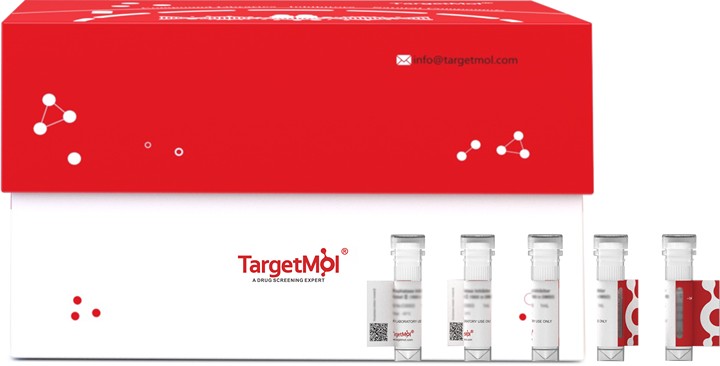 您的购物车当前为空
您的购物车当前为空
S100A14 Protein, Human, Recombinant (His)
一键复制产品信息S100 protein is a family of low molecular weight protein found in vertebrates characterized by two EF-hand calcium-binding motifs. There are at least 21 different S100 proteins, and the name is derived from the fact that the protein is 100% soluble in ammonium sulfate at neutral pH. Most S100 proteins are disulfide-linked homodimer, and is normally present in cells derived from theneural crest, chondrocytes, macrophages, dendritic cells, etc. S100 proteins have been implicated in a variety of intracellular and extracellular functions. They are involved in regulation of protein phosphorylation, transcription factors, the dynamics of cytoskeleton constituents, enzyme activities, cell growth and differentiation, and the inflammatory response. Protein S100-A14, also known as S100 calciumbinding protein A14, S114 and S100A14, is a cytoplasm protein which belongs to the S-100 family. It is expressed at highest levels in colon and at moderate levels in thymus, kidney, liver, small intestine, and lung. Low expression in heart and no expression is seen in brain, skeletal muscle, spleen, placenta and peripheral blood leukocytes.

S100A14 Protein, Human, Recombinant (His)
一键复制产品信息| 规格 | 价格 | 库存 | 数量 |
|---|---|---|---|
| 5 μg | ¥ 187 | 6-8日内发货 | |
| 10 μg | ¥ 285 | 6-8日内发货 | |
| 20 μg | ¥ 457 | 5日内发货 | |
| 50 μg | ¥ 858 | 5日内发货 | |
| 100 μg | ¥ 1,680 | 5日内发货 | |
| 200 μg | ¥ 2,180 | 5日内发货 | |
| 500 μg | ¥ 3,870 | 5日内发货 | |
| 1 mg | ¥ 6,820 | 5日内发货 |
产品信息
| 生物活性 | Activity testing is in progress. It is theoretically active, but we cannot guarantee it. If you require protein activity, we recommend choosing the eukaryotic expression version first. |
| 产品描述 | S100 protein is a family of low molecular weight protein found in vertebrates characterized by two EF-hand calcium-binding motifs. There are at least 21 different S100 proteins, and the name is derived from the fact that the protein is 100% soluble in ammonium sulfate at neutral pH. Most S100 proteins are disulfide-linked homodimer, and is normally present in cells derived from theneural crest, chondrocytes, macrophages, dendritic cells, etc. S100 proteins have been implicated in a variety of intracellular and extracellular functions. They are involved in regulation of protein phosphorylation, transcription factors, the dynamics of cytoskeleton constituents, enzyme activities, cell growth and differentiation, and the inflammatory response. Protein S100-A14, also known as S100 calciumbinding protein A14, S114 and S100A14, is a cytoplasm protein which belongs to the S-100 family. It is expressed at highest levels in colon and at moderate levels in thymus, kidney, liver, small intestine, and lung. Low expression in heart and no expression is seen in brain, skeletal muscle, spleen, placenta and peripheral blood leukocytes. |
| 种属 | Human |
| 表达系统 | E. coli |
| 标签 | N-His |
| 蛋白编号 | Q9HCY8 |
| 别名 | S100A15,S100 calcium binding protein A14,BCMP84 |
| 蛋白构建 | A DNA sequence encoding the native human S100A14 (NP_065723.1) (Gly 2-His 104) was expressed, with a polyhistide tag at the N-terminus. Predicted N terminal: Met |
| 蛋白纯度 | > 85 % as determined by SDS-PAGE |
| 分子量 | 13 kDa (predicted); 13 kDa (reducing conditions) |
| 内毒素 | Please contact us for more information. |
| 蛋白性状 | Solution |
| 缓冲液 | Supplied as sterile 50 mM Tris, 20% glycerol, pH 7.5. |
| 复溶方法 | A Certificate of Analysis (CoA) containing reconstitution instructions is included with the products. Please refer to the CoA for detailed information. |
| 存储 | It is recommended to store the product under sterile conditions at -20°C to -80°C. Samples are stable for up to 12 months. Please avoid multiple freeze-thaw cycles and store products in aliquots. |
| 运输方式 | In general, Lyophilized powders are shipping with blue ice. Solutions are shipping with dry ice. |
| 研究背景 | S100 protein is a family of low molecular weight protein found in vertebrates characterized by two EF-hand calcium-binding motifs. There are at least 21 different S100 proteins, and the name is derived from the fact that the protein is 100% soluble in ammonium sulfate at neutral pH. Most S100 proteins are disulfide-linked homodimer, and is normally present in cells derived from theneural crest, chondrocytes, macrophages, dendritic cells, etc. S100 proteins have been implicated in a variety of intracellular and extracellular functions. They are involved in regulation of protein phosphorylation, transcription factors, the dynamics of cytoskeleton constituents, enzyme activities, cell growth and differentiation, and the inflammatory response. Protein S100-A14, also known as S100 calciumbinding protein A14, S114 and S100A14, is a cytoplasm protein which belongs to the S-100 family. It is expressed at highest levels in colon and at moderate levels in thymus, kidney, liver, small intestine, and lung. Low expression in heart and no expression is seen in brain, skeletal muscle, spleen, placenta and peripheral blood leukocytes. |





 |
|